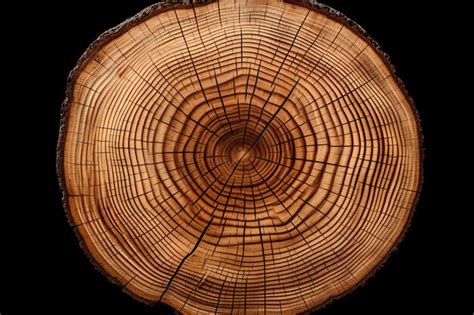A tree trunk, an unassuming yet colossal structure, holds within its depths a fascinating world of biological complexity and engineering brilliance. By examining the intricate cross section of a tree trunk, we gain invaluable insights into the life and function of these arboreal giants.

The Anatomy of a Tree Trunk
The cross section of a tree trunk reveals a distinct layering system, each layer serving a specific role in the tree’s growth, support, and nutrient transport.
-
Bark: The outermost layer, protecting the vulnerable inner tissues from damage and environmental stress.
-
Cambium: A thin, actively dividing layer that produces new bark and wood.
-
Sapwood: Living, moisture-conducting tissue that transports water and nutrients from the roots to the leaves.
-
Heartwood: Central, non-living wood that provides structural support and resists decay.
The Growth Rings: A Timeline of a Tree’s Life
Embedded within the sapwood and heartwood are concentric rings known as growth rings. Each ring represents one year of growth, with the width of the ring indicating the environmental conditions during that year. Wider rings indicate favorable growing conditions, while narrower rings suggest drought or stress.
By counting the growth rings, we can estimate the age of the tree. For example, a tree with 150 growth rings has lived for approximately 150 years.
The Vascular System: The Tree’s Lifeline
The vascular system of a tree is responsible for transporting essential nutrients and water throughout the plant. It consists of two main components:
-
Xylem: A network of vessels that transports water and dissolved minerals from the roots to the leaves.
-
Phloem: Another network of vessels that transports sugars and other nutrients from the leaves to the rest of the plant.
The distribution and arrangement of the xylem and phloem within the tree trunk play a crucial role in the overall efficiency of the vascular system.
The Hidden World of Wood Structures
The cross section of a tree trunk reveals a kaleidoscope of cellular structures that contribute to the tree’s strength and resilience. These structures include:
-
Tracheids: Hollow, elongated cells that form the primary water-conducting cells in gymnosperms (e.g., pines and spruces).
-
Vessel Elements: Larger, interconnected cells found in angiosperms (e.g., oaks and maples), forming an efficient water transport system.
-
Fibers: Long, slender cells that provide structural support and resistance to bending.
Wood Properties and Applications
The unique structure and composition of wood impart specific properties that make it a versatile and widely used material across industries.
-
Strength: Wood’s cellular structure gives it exceptional strength-to-weight ratio, making it suitable for construction, furniture, and sports equipment.
-
Durability: Heartwood is highly resistant to decay, making it ideal for outdoor applications such as decks, fences, and boat building.
-
Insulation: Wood’s cellular structure traps air, providing excellent thermal insulation for buildings and homes.
Tips and Tricks for Studying Tree Cross Sections
-
Proper Sectioning: Use a sharp saw or chisel to create a smooth, clean cross section.
-
Magnification: Employ a magnifying glass or microscope to examine the fine details of the cellular structures.
-
Identification Keys: Utilize field guides or online resources to assist in identifying different wood species based on their anatomical characteristics.
Common Mistakes to Avoid
-
Over-sharpening: Sharpening the saw or chisel excessively can tear the wood fibers, obscuring the cellular structures.
-
Improper Storage: Store cross sections in a dry, well-ventilated environment to prevent warping and decay.
-
Jumping to Conclusions: Avoid hasty assumptions when analyzing growth rings. Consider factors such as environmental conditions and species characteristics.
FAQs
-
How old is a tree with 200 growth rings?
– Approximately 200 years old. -
What is the difference between sapwood and heartwood?
– Sapwood is living, moisture-conducting tissue, while heartwood is non-living, providing structural support. -
What factors influence the width of growth rings?
– Environmental conditions such as temperature, precipitation, and soil fertility. -
What is the role of fibers in wood?
– Providing structural support and resistance to bending. -
What is a technique to study the cellular structures of wood?
– Microscopic examination using thin cross sections. -
How is wood used in construction?
– As building materials, frames, and flooring due to its strength, durability, and insulation properties.
Conclusion
The cross section of a tree trunk is a rich source of information about the life, growth, and function of these majestic organisms. By delving into the intricate layers, cellular structures, and vascular systems, we gain a deeper appreciation for the wonders of nature and the valuable resource that wood provides. Understanding the anatomy of tree trunks not only enriches our scientific knowledge but also informs our choices in forestry, construction, and the appreciation of the natural world.
